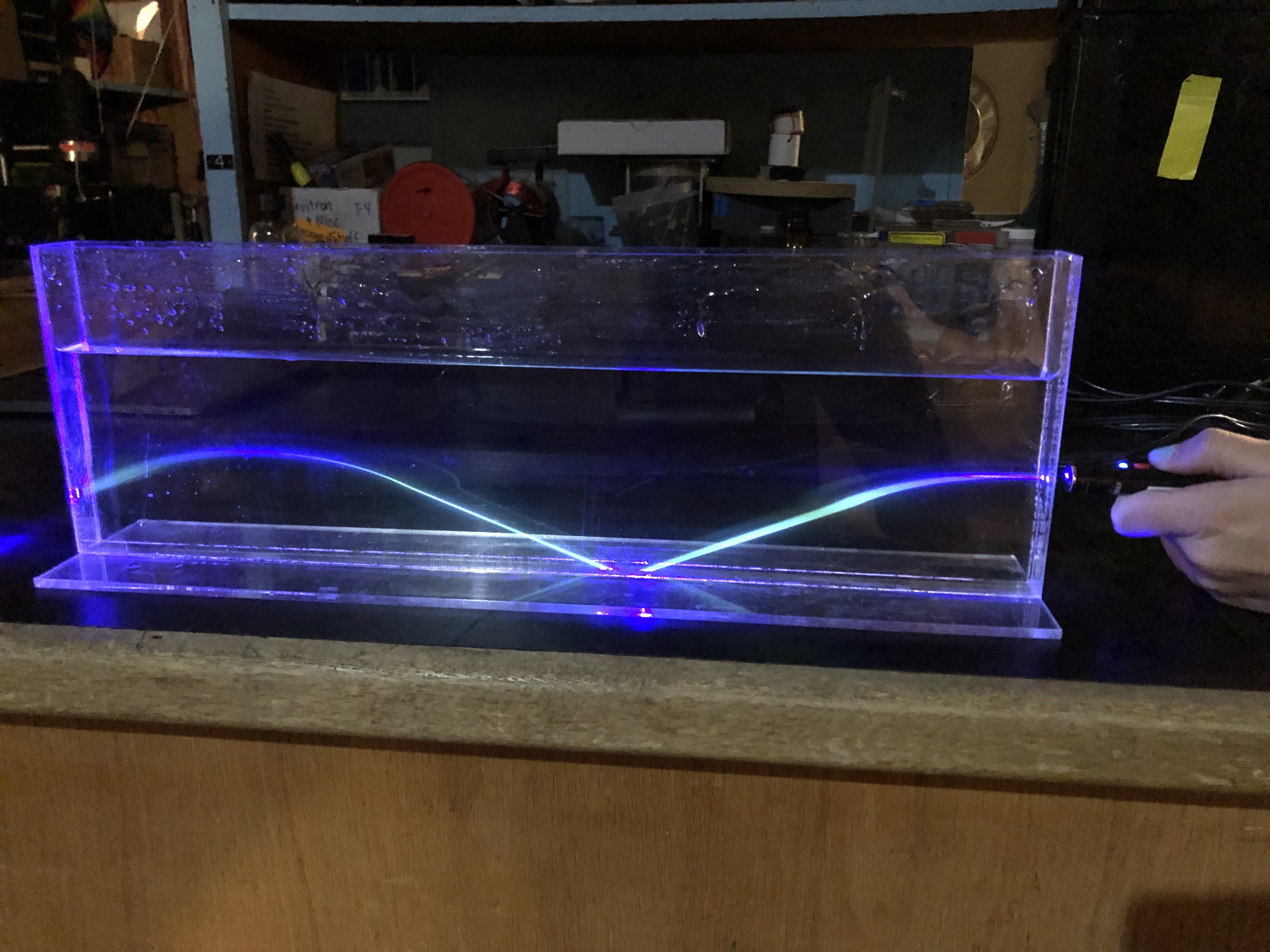Difference between revisions of "Bouncing Laser"
From UO Physics Demonstration Catalog
| Line 3: | Line 3: | ||
This demonstration is difficult to set up, and ample time should be allowed for it to be set up properly. This requires at least a day in advance so that the water and syrup can sit overnight. | This demonstration is difficult to set up, and ample time should be allowed for it to be set up properly. This requires at least a day in advance so that the water and syrup can sit overnight. | ||
A 1:1 solution of Karo syrup and water is left to sit overnight to make a gradient of syrup and water solution . Start with About 2 inches of syrup on the bottom./ Add water that has had the air bubbles taken out by boiling and the let cool down, or put water in a vacuum chamber to get the air bubbles out. Pour the water on top of the syrup in the narrow tank. Carefully and gently stir the syrup and water with an upward motion to get syrup to come up into the water and then resettle DO NOT OVER-STIR! Let sit for a few hours or overnight | A 1:1 solution of Karo syrup and water is left to sit overnight to make a gradient of syrup and water solution . Start with About 2 inches of syrup on the bottom./ Add water that has had the air bubbles taken out by boiling and the let cool down, or put water in a vacuum chamber to get the air bubbles out. Pour the water on top of the syrup in the narrow tank. Carefully and gently stir the syrup and water with an upward motion to get syrup to come up into the water and then resettle DO NOT OVER-STIR! Let sit for a few hours or overnight. | ||
<span style="color:#0000ff"> We also had good results by mixing simple syrup (~1:1 ratio of Karo Syrup and water) and adding a layer of water on top of the simple syrup. i.e. Rather than a 2 inch layer of straight Karo syrup, use simple syrup for that layer and add water on top with no further stirring.</span> | |||
<span style="color:#0000ff">We also had good results by mixing simple syrup (~1:1 ratio of Karo Syrup and water) and adding a layer of water on top of the simple syrup. i.e. Rather than a 2 inch layer of straight Karo syrup, use simple syrup for that layer and add water on top with no further stirring.</span> | |||
A bright laser is shined into one end of the plexiglass tank, and it is seen to bend because of the varying index of refraction from the bottom to the top layer. When the beam hits the bottom of the tank, it encounters total internal reflections and reflects back up, then curves down again, making it appear that the beam is bouncing. | A bright laser is shined into one end of the plexiglass tank, and it is seen to bend because of the varying index of refraction from the bottom to the top layer. When the beam hits the bottom of the tank, it encounters total internal reflections and reflects back up, then curves down again, making it appear that the beam is bouncing. | ||
Latest revision as of 11:44, 2 May 2023
Return to Refraction and Dispersion
Description:
This demonstration is difficult to set up, and ample time should be allowed for it to be set up properly. This requires at least a day in advance so that the water and syrup can sit overnight.
A 1:1 solution of Karo syrup and water is left to sit overnight to make a gradient of syrup and water solution . Start with About 2 inches of syrup on the bottom./ Add water that has had the air bubbles taken out by boiling and the let cool down, or put water in a vacuum chamber to get the air bubbles out. Pour the water on top of the syrup in the narrow tank. Carefully and gently stir the syrup and water with an upward motion to get syrup to come up into the water and then resettle DO NOT OVER-STIR! Let sit for a few hours or overnight.
We also had good results by mixing simple syrup (~1:1 ratio of Karo Syrup and water) and adding a layer of water on top of the simple syrup. i.e. Rather than a 2 inch layer of straight Karo syrup, use simple syrup for that layer and add water on top with no further stirring.
A bright laser is shined into one end of the plexiglass tank, and it is seen to bend because of the varying index of refraction from the bottom to the top layer. When the beam hits the bottom of the tank, it encounters total internal reflections and reflects back up, then curves down again, making it appear that the beam is bouncing.
Location:
- Laser: Shelf M-2
- Tank: Shelf M-1
- Kari Syrup: Under Fume Hood
